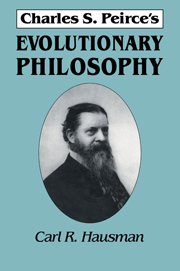4 - SYNECHISM AND PEIRCE'S EVOLUTIONARY REALISM
Published online by Cambridge University Press: 07 January 2010
Summary
Introduction
A theme central to the discussion in this book has been the expression of the belief that Peirce's philosophy presupposes an architectonic founded primarily on a form of realism. There are reasons for resisting this interpretation, however, as I have already suggested. It has been claimed that Peirce was fundamentally an idealist. This difference is understandable, for there is a sense in which he was an idealist and a sense in which he was a realist. Hence it may be claimed that he was a kind of metaphysical idealist and, at the same time, an epistemological realist. On this view, he was an idealist metaphysically in the sense that the final object of thought in general, the final aim of investigation, is regarded as not only completely thought-dependent but also mental in nature. He was a realist epistemologically, then, in the sense that in the context of any theoretical investigation, what investigation is about is independent of that investigation, but what is independent is thought or theory that is not exhausted by the particular theoretical framework at the time. I think this is a misleading suggestion. My purpose in the first section, then, will be to show why it is misleading and to propose that Peirce's conception of the constraints of an extrasemeiotic or extraepistemic condition has a fundamental function that aligns him with a special form of metaphysical realism – what I have called evolutionary realism.
The proposal that his is an evolutionary realism will, I hope, make clear that I believe Peirce wanted and managed to push beyond the traditional labels idealism and realism.
- Type
- Chapter
- Information
- Charles S. Peirce's Evolutionary Philosophy , pp. 140 - 193Publisher: Cambridge University PressPrint publication year: 1993



